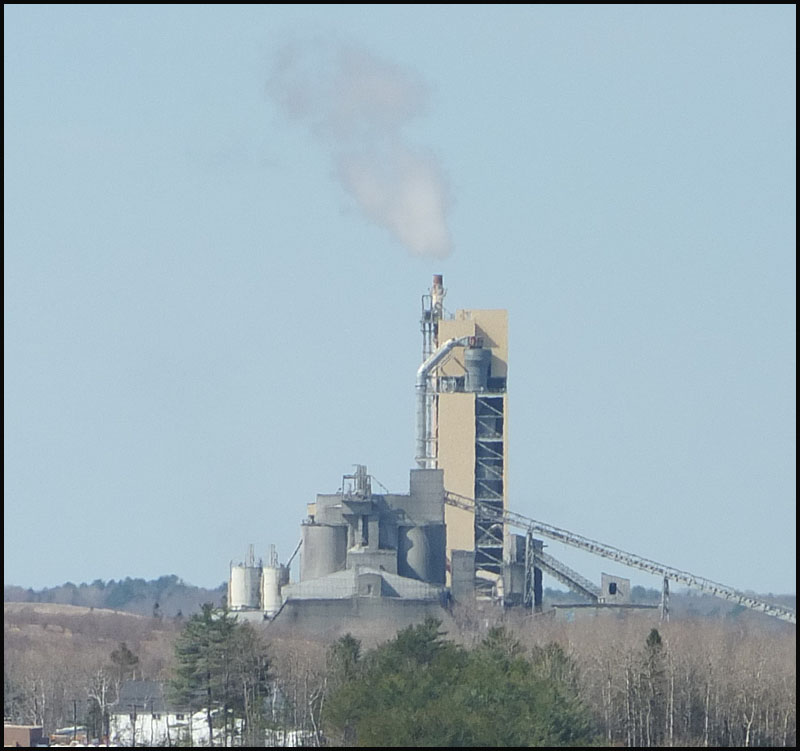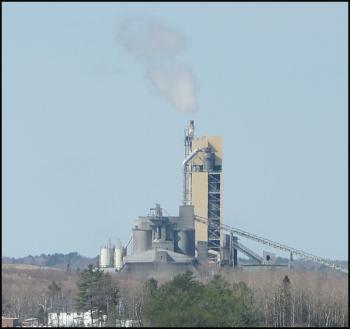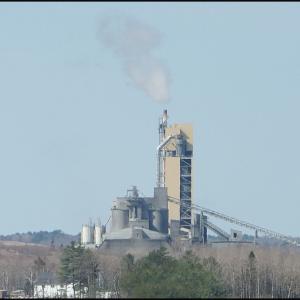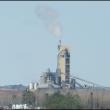Maine reviews Dragon’s request to burn alternative fuel – asphalt shingles, plastic – in cement-making process
THOMASTON — The Maine Department of Environmental Protection is reviewing applications from Dragon Products, LLC, the cement-making plant in Thomaston, to modify licenses to allow combustion of asphalt shingles, post-consumer carpet and padding, and plastics, as alternative fuels.
The air emission application was filed in February and accepted as complete on March 1 by the DEP, which means it is in line for full review for a license change. The application to modify the company’s fuel substitution license is also under review at the DEP’s Division of Solid Waste Management.
(See attached PDFs for both applications)
To Dragon Evironmnetal Manager Michael Martunas, some of the material burned will end up in the clinker, which ultimately becomes cement, but it is the thermal benefit of using the asphalt and plastic as fuel that the company wants.
“And we are interested in keeping it out of the landfills,” he said.
Currently, the recycling markets for plastic and other debris, such as carpets and shingles, have shrunk. Dragon sees the opportunity in tapping that material as a fuel for its high-temperature kiln, and reducing its reliance on petroleum coke.
According to Petro Industry News: “Petcoke is a byproduct created when bitumen found in tar sands, like those in Alberta, Canada, is refined into crude oil. Bitumen contains a higher number of carbon atoms than regular oil and it’s these atoms, extracted from large hydrocarbon molecules using heat, that go on to form petcoke.”
Because it releases more carbon per unit of energy than normal coal, it is large contributor to greenhouse gases, Petro Industry News said.
The Environmental Protection Agency has its own concerns about fugitive dust from petrocoke storage and handling operations presenting a health risk.
Dragon is allowed, through its environmental permits, to operate its kiln with 50 percent substitution of alternative fuel. Currently, and besides petrocoke, it uses No. 2 fuel to fire up its kiln, and on-spec used oil. Since 2013, it has also incorporated tire chips and automotive carpets as alternative fuels for its cement-making process.
Dragon Products, which is a subsidiary of the Mexican-owned company, Elementia, manufactures cement, using limestone mined from local quarries. Elementia, based in Mexico City, acquired Dragon in 2016 through its acquisition of a 55 percent stake, and full control of Giant Cement Holdings, Inc., from the Spanish company, Cementos Portland Valderrivas.
Dragon has been part of the Midcoast landscape for much longer, since the early 1900s, when manufacturers first started mining limestone quarries and making Portland cement at the Thomaston facility. Over the last century, the plant has grown its footprint to 1,100 acres.
Dragon currently employs 85-88 workers at the Thomaston plant, and still actively mines its 130-open acre quarry.
The plant itself sits on approximately 250 acres, and the other 700 acres, according to Environmental Manager Michael Martunas, remains undeveloped.
In 2010, it produced approximately 300,000 tons of cement.
According to Martunas, Dragon has “plenty of reserves” to continue making cement for years to come — “it may outlast both of us,” he said, in a conversation.
The decisions of which fuels to use are made at the Thomaston plant, said Environmental Manager Michael Martunas.
He talked with the Maine Resource Recovery Association last year about incorporating material from Maine transfer stations — Rockland, Rockport and St. George, in particular — for alternative fuels.
“We are not looking for out-of-state” material, he said.
He said that while Dragon has some predictions from its testing about how much recyclable materials to burn, “the financials have not been hashed out, yet.”
According to the company’s application for its fuel substitution license modifications, Dragon would, “consume 100 percent of the alternative fuel material received.”
Test runs
Portland cement, according to the Portland Cement Association, is a basic ingredient of concrete. Cement is made through a “closely controlled chemical combination of calcium, silicon, aluminum, iron and other ingredients. Materials used in the process include limestone, shells, clay, slate, blast furnace slag, iron ore, which are fired in a kiln to produce clinker. Clinker is the main ingredient in Portland cement.
For years, the Thomaston Dragon plant has used limestone from its quarry. The limestone is pulverized and mixed with sand and iron, fed to the kiln system, “where it is heated to near liquid phase in the rotary kiln, then cooled quickly to produce clinker, the maine ingredient in Portland cement,” according to Dragon’s air emission application.
Dragon has been using approximately 10 tons of petroleum coke per hour in its rotary kiln and its calciner. The plant is currently licensed to burn tire chips (which arrive in 1.5 to 2-inch pieces) and recycled carpet materials (typically from the auto industry from car interior upholstery) as alternative fuel, and used in the calciner.
Now, Dragon wants to expand what it uses to make cement and include:
recycled asphalt shinges
recycled post-consumer carpet
recycled post-consumer carpet foam padding
recycled high density polyethylene (HDPE) plastics (No. 2)
recycled plastics (RP) (No. 1, 3, 4, 5 and 7)
In 2018, Dragon burned 22 tons of asphalt shingles and reported no adverse effects on the air emission quality nor clinker chemistry.
In a 2008 industry report by the company Owens Corning about the viability of burning asphalt shingles, the author wrote: “An asphalt roofing shingle contains both organic and inorganic materials. The organic materials (from the asphalt coating, sealant, adhesives, felt, etc.) have potential value as fuel. The inorganic materials (from the granules, limestone filler, backdust sand, glass mat, etc.) have potential value as raw materials for processes that use the various minerals they contain.”
Dragon likewise reported no air nor clinker quality issues with the burning of 11 tons of post-consumer carpet and foam padding, and 29 tons of recycled plastic.
Dragon had also conducted tests in 2018 on other materials, including conveyor belt material, coal tar pitch, Earthlife bio-solids and Fiberform graphite and carbon, but determined them unsuitable.
The biosolids (wastewater and sewage fertilizer products produced at the New England Fertilizer Company plant) proved problematic because of the small size of the pellets, and increased mercury emissions.
Due to its durability and composition, the conveyer belt material bound up the shredder at the Dragon plan, proving it inadequate for the process.
The graphite and carbon, coal tar pitch and coke was unsuccessful in the first testing phase, Dragon said in a February 2019 summary.
That material, from the Biddeford-based Fiber Materials, Inc., plant, which produces composites for industrial and aerospace applications, was too dusty during the processing.
But, Dragon said it intends to reevaluate the material via an alternate method and will submit an amended letter of intent to the DEP for additional trials.
Adding the recyclable stream
In its application to the DEP’s waste management bureau, Dragon said it would maintain a contract with its generator/supplier of the alternative fuel to return any unused material, or arrange for its proper disposal.
Those alternative fuels would arrived via bulk trailers, with the carpets and padding and plastics delivered in bales, which would be stored on a concrete bed, with concrete barriers.
There is no residual ash from the combustion process, Drago said, and all raw materials and fuels used in the process end up as a component of the clinker.
Martunas said the environmental effects of burning the alternative fuels will be monitored through its air emissions monitors, which run, “24-7.”
Dragon installed its additional continuous emission monitoring system (CEMS) in 2015, after the EPA revised its Portland cement air emission rules.
Dragon has been monitoring nitrogen oxides, sulfur oxides, carbon monoxide, and opacity since the 1980s, said Martunas.
The CEMS, according to the EPA, “is the total equipment necessary for the determination of a gas or particulate matter concentration or emission rate using pollutant analyzer measurements and a conversion equation, graph, or computer program to produce results in units of the applicable emission limitation or standard.”
For cement plants, CEMS equipment includes bathhouses and optics.
In Dragon’s case, the emissions monitored include nitrogen oxides, sulfur oxides, carbon monoxide, carbon dioxide, total hydrocarbons, mercury, hydrogen chloride, particulate matter, as well as temperature an air flow, said Martunas.
If the DEP approves the license modifications, Dragon would begin adding the plastics, shingles and carpet to the fuel mix in June or “July-ish,” he said.
A destructive two-alarm fire at the plant that drew the response from 11 Midcoast fire departments has Dragon under repair, with no clinker-making expected until mid-May, said Martunas. There was, he said, significant damage to electrical components.
When the kiln does get re-fired, and if the DEP endorses the idea of expanding the list of alternative fuels, Martunas said he wants to see the waste loop better closed by burning the plastics and shingles, and “help the process of making cement.”
“I think it will be a good opportunity for Dragon and the local communities,” he said. “We have the opportunity to keep the material out of the landfills.”
As for the DEP, it’s a matter of reviewing the applications and test emissions, both in what Dragon has submitted and in the DEP’s own monitoring, which it says it conducts.
“If they can make it work well and it doesn't impact emissions, it should be a good material,” said Benjamin Goundie, who is with the Bureau of Air Quality, at the DEP.
Reach Editorial Director Lynda Clancy at lyndaclancy@penbaypilot.com; 207-706-6657
























